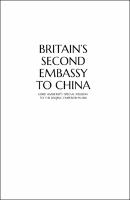Britain's Second Embassy to China
Lord Amherst's 'Special Mission' to the Jiaqing Emperor in 1816
Abstract
Lord Amherst's diplomatic mission to the Qing Court in 1816 was the second British embassy to China. The first led by Lord Macartney in 1793 had failed to achieve its goals. It was thought that Amherst had better prospects of success, but the intense diplomatic encounter that greeted his arrival ended badly. Amherst never appeared before the Jiaqing emperor and his embassy was expelled from Peking on the day it arrived. Historians have blamed Amherst for this outcome, citing his over-reliance on the advice of his Second Commissioner, Sir George Thomas Staunton, not to kowtow before the emperor. Detailed analysis of British sources reveal that Amherst was well informed on the kowtow issue and made his own decision for which he took full responsibility. Success was always unlikely because of irreconcilable differences in approach. China’s conduct of foreign relations based on the tributary system required submission to the emperor, thus relegating all foreign emissaries and the rulers they represented to vassal status, whereas British diplomatic practice was centred on negotiation and Westphalian principles of equality between nations. The Amherst embassy’s failure revised British assessments of China and led some observers to believe that force, rather than diplomacy, might be required in future to achieve British goals. The Opium War of 1840 that followed set a precedent for foreign interference in China, resulting in a century of 'humiliation’. This resonates today in President Xi Jinping’s call for ‘National Rejuvenation’ to restore China’s historic place at the centre of a new Sino-centric global order.
Keywords
China; Britain; British Empire; William Pitt; Amherst; Canton; Kowtow; tributary systemDOI
10.22459/BSEC.2020ISBN
9781760464097, 9781760464097Publisher
ANU PressPublisher website
https://press.anu.edu.au/Publication date and place
Canberra, 2021Imprint
ANU PressClassification
European history
Asian history
History and Archaeology
c 1500 onwards to present day


 Download
Download